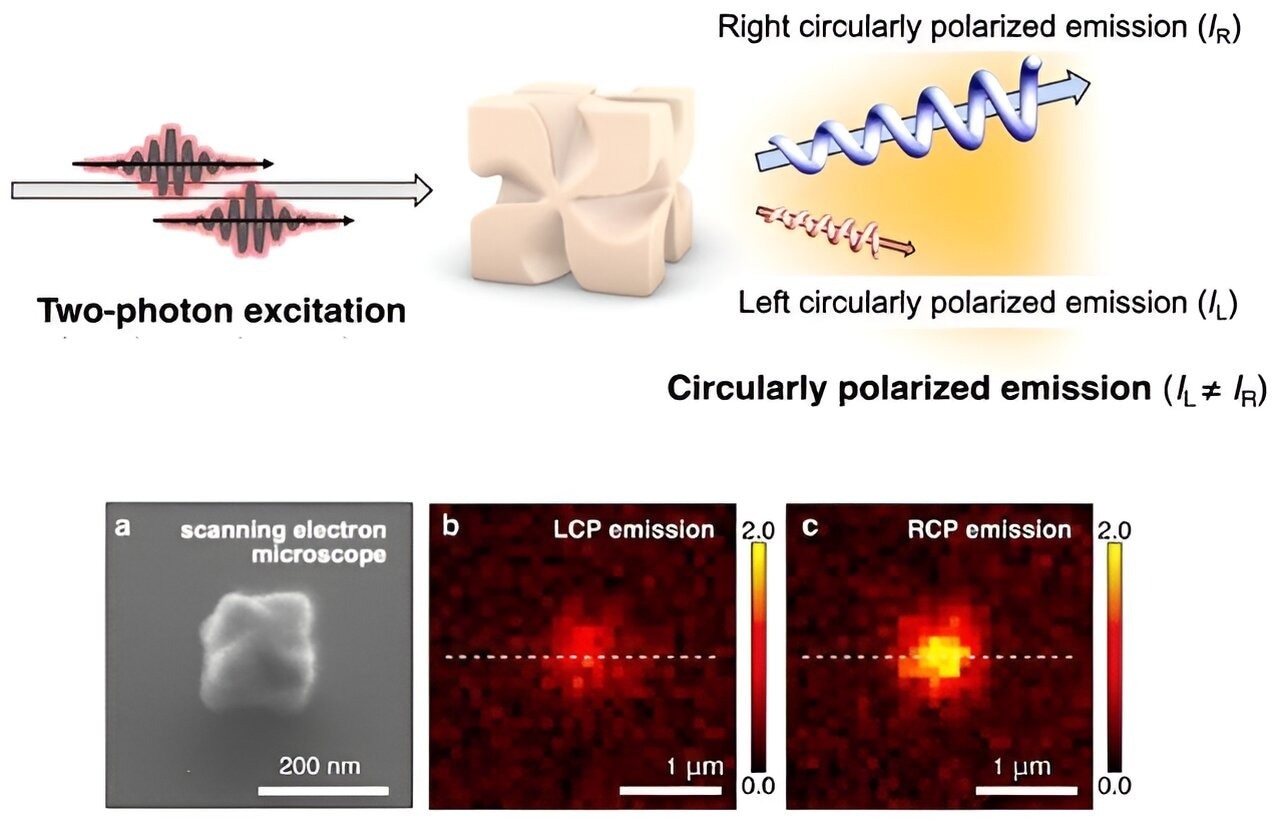Researchers from the Institute for Molecular Science and Seoul National University have found that the visible luminescence from chiral gold nanoparticles, when exposed to near-infrared femtosecond pulses, depends on the nanoparticles' chirality. This process achieves high selectivity for either left- or right-handed circularly polarized light.
 (Upper panel) Experimental scheme. When a chiral gold nanoparticle is illuminated with near-infrared linearly polarized femtosecond light pulses, circularly polarized luminescence is observed in the visible region. (Lower panels) From left to right, scanning electron micrograph of the chiral gold nanoparticle (a), microscopic image detecting the left-circularly polarized luminescence (b), and the image detecting the right-circularly polarized luminescence (c). Image Credit: Hiromi Okamoto, Hyo-Yong Ahn
(Upper panel) Experimental scheme. When a chiral gold nanoparticle is illuminated with near-infrared linearly polarized femtosecond light pulses, circularly polarized luminescence is observed in the visible region. (Lower panels) From left to right, scanning electron micrograph of the chiral gold nanoparticle (a), microscopic image detecting the left-circularly polarized luminescence (b), and the image detecting the right-circularly polarized luminescence (c). Image Credit: Hiromi Okamoto, Hyo-Yong Ahn
When chiral gold nanoparticles are irradiated with near-infrared femtosecond pulses, they exhibit visible luminescence with a high selectivity for left- or right-handed circularly polarized light, depending on the chirality of the nanoparticles. A study published in Advanced Optical Materials found that this luminescence yields a dissymmetry factor of approximately 0.7, suggesting potential applications for circularly polarized light in practical fields.
These chiral gold nanoparticles showed a significant dissymmetry factor of about 0.7 in their emission, whereas most chiral materials normally have a dissymmetry factor of 0.01 or less for circular polarization of luminescence.
Chirality is a feature of materials in which the structure cannot be superimposed on a mirror image of itself. Light contains a chiral structure in the form of circular polarization, which can be either left- or right-handed. Future uses for circularly polarized light include trace analysis of chiral substances, anti-counterfeiting, quantum information, screens or displays, and so on.
Several research publications on effective generating methods for circularly polarized light have been published. One such way is to generate circular polarization by luminescence from a material stimulated by light, where the wavelengths of the excitation and emitted light vary.
While numerous studies have been conducted to produce materials that induce circular polarization using this approach, in most cases, the dissymmetry factors are minor. That is, they generate both left- and right-handed circularly polarized light, with just a tiny intensity variation between them.
The dissymmetry factor indicates how much circular polarization is biased to be left- or right-handed. It is calculated as the difference between the left- and right-circularly polarized intensities divided by their average. Pure circular polarization has a dissymmetry factor (g value) of ±2, whereas linear or unpolarized light has a g value of 0.
Most traditional circularly polarized light-emitting materials have a dissymmetry factor of 0.01 or less, making it difficult to recognize the resulting circularly polarized light.
This study focused on the visible luminescence produced when chiral gold nanoparticles were exposed to near-infrared femtosecond pulses. Although the incident light was non-chiral and linearly polarized, the emitted light was discovered to be extremely selective for either left- or right-handed circular polarization.
The dissymmetry factor was at 0.7, showing a substantially higher degree of circular polarization than many other circularly polarized light-emitting materials studied before (dissymmetry values are normally around 0.01 or less). Furthermore, theoretical calculations and analyses identified the mechanism underlying this high selectivity.
This study shows that chiral structured metal nanoparticles are effective materials for producing circularly polarized light that is biased to left- or right-handed polarization. Understanding this technique also leads to more efficient circular polarization generation.
This discovery paves the way for the development of materials and technologies capable of effectively generating circular polarization at diverse wavelengths, as well as applications in anti-counterfeiting and quantum information utilizing circularly polarized light.
Journal Reference:
Ahn, H.-Y., et al. (2024) Highly Chiral Light Emission Using Plasmonic Helicoid Nanoparticles. Advanced Optical Materials. doi:10.1002/adom.202400699